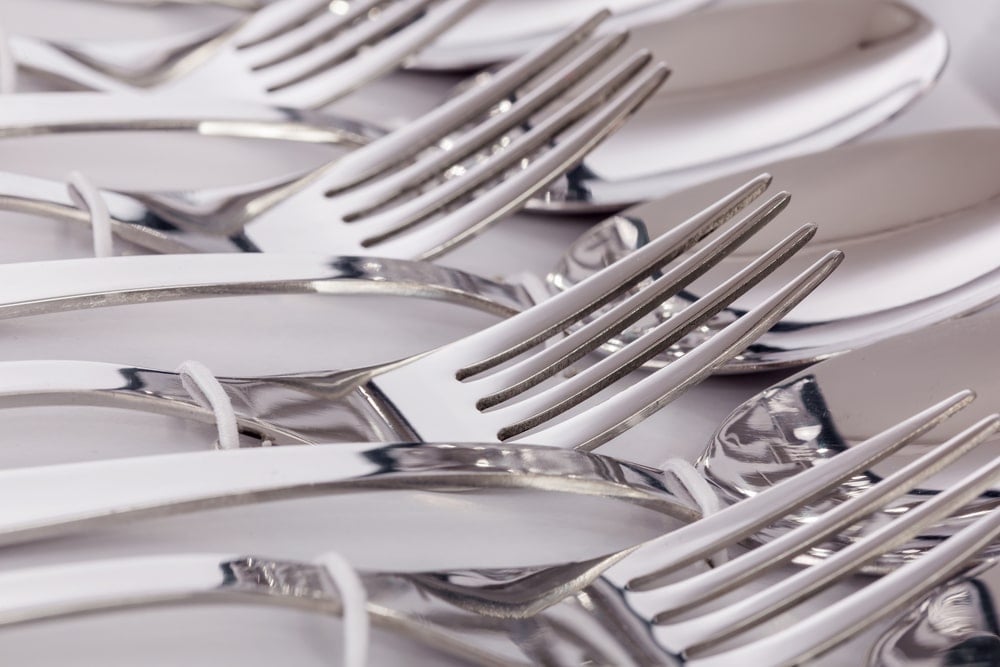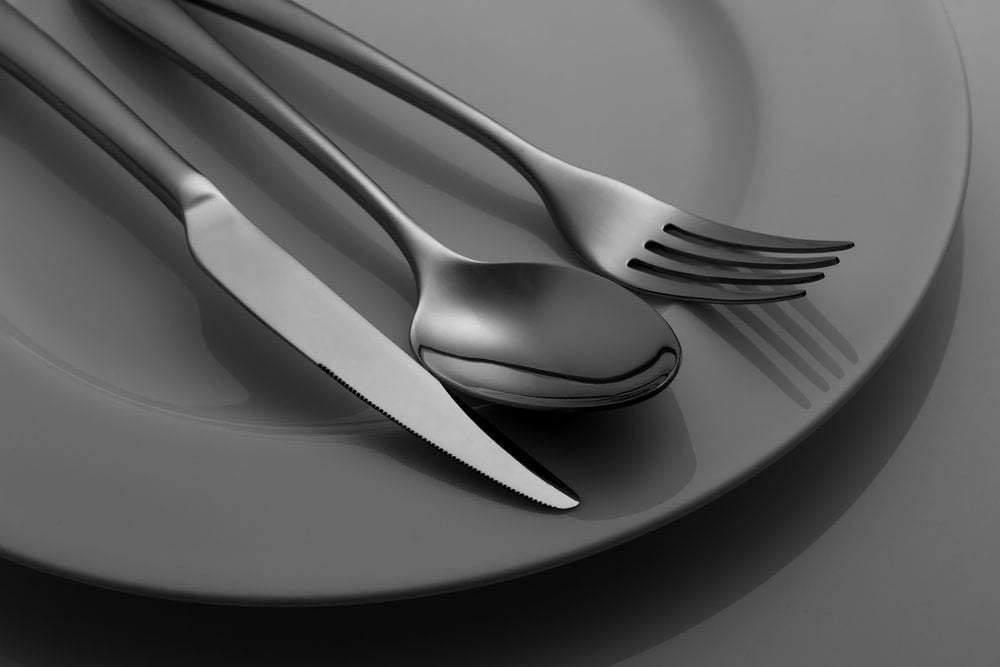
Have you ever been to a party and been directed to plastic “silverware” utensils? If you thought to yourself, that doesn’t really seem like silverware, you would be correct. Over the years, the terms silverware and flatware have become somewhat interchangeable, but there are substantial differences between silverware and flatware in terms of quality, durability, and value. What will work for you can vary greatly depending on your needs. Do you need sterling silverware for a kid’s birthday party? Probably not. Do you want to have a formal silver table setting for formal occasions? Perhaps, but there’s a lot to consider, including cost, maintenance, and durability. There’s also stainless steel, silverplated, and a wide selection of possibilities.
Related: Types of Tools for Eating Seafood
What is Flatware?

Flatware consists of spoons, forks, and other serving items used for meals. Technically, it does not include knives, as knives are cutlery. But, in the U.S., when people say flatware, they often include knives, and the term generically refers to all table utensils. Essentially when we are talking about flatware, we are talking about table settings. In general, flatware is used somewhat interchangeably with silverware, but there is a big difference between the two. Flatware is somewhat all-encompassing. It can be plastic, stainless steel, acrylic, and silverplated. Flatware is what most people use every day in their homes or at restaurants. The quality of flatware can vary depending on the materials used.
What is Silverware?

Silverware is anything derived almost entirely from silver. When we talk about silverware, it means something made of silver – at least 92.5 percent silver, to be exact. In common usage, silverware generically refers to utensils, but this is technically incorrect. Silverware is made primarily of silver. Nowadays, authentic silverware is usually called “sterling silverware.” Over time the term has been used to apply to almost any table setting. One reason for this is that sterling silverware is very expensive and mainly used for more formal occasions.
Benefits of Sterling Silverware

Historically, silverware became a popular option for eating utensils in part because, as a metal, it is not very chemically reactive. Silver even is less chemically reactive than gold. Eating utensils made from other metals can sometimes create an odd taste because the metal might react with the food. Real silverware is the best in terms of quality and style. The look and feel of authentic silverware are fairly distinct. If you have a sterling silverware set, you might be inclined to display it when you are not using it. Flatware, in general, is more durable, and higher-end flatware can look pretty good. Overall it tends to be much more practical.
Types of Flatware
For household flatware you intend to use for a long time, there is a range of styles and materials from which to choose. The quality of your flatware will impact whether it rusts or tarnishes and how long it lasts. One option is to have a flatware set you use for everyday needs, and then have a somewhat fancier set – perhaps silver-plated – for more formal events or special dinners like Thanksgiving.
Plastic

The disposable kind of flatware is plastic and probably best for one time events like a child’s birthday party. There are different levels of quality, even for plastic flatware. Premium rose gold, for example, is an excellent option for a more formal backyard event like a wedding. Just because it’s plastic, it doesn’t have to look or seem cheap. If you are having a kid’s birthday party, go with the lower quality transparent plastic flatware, but you can find some beautiful, still affordable, disposable flatware for fancier occasions.
Stainless steel

This type of flatware is rust-resistant and does not tarnish or chip. Stainless steel is durable and meant to last, and it is the type of table setting most families use regularly. Stainless steel flatware is rated based on the quality and the materials used in it. In general, the amount of chromium and nickel used in flatware determines the quality rating. The minimum amount of chromium that is in all stainless steel flatware is 10.5 percent. The chromium is what gives the flatware its durability. Nickel also is added to give it a shine and to help prevent prevents corrosion. Stainless steel flatware has four ratings based on the amount of nickel and chromium it contains: 13/0, 18/0, 18/8, and 18/10, with 18/10 being the best, longest-lasting grade. The quality grade will impact the price. What you end up buying will largely depend on your intended use. For daily use, you probably want something that will be fairly durable and will last.
Silverplated

Silverplated flatware is exactly what it sounds like – a coat of silver covering another metal. Usually, the silver plating is covering nickel, brass, or some other metal. The coated metal largely determines the quality of the flatware, with nickel being the best as it will last the longest. Nickel is harder than many other materials and tends to adhere well to the silver. Silverplated flatware can give the appearance and feel of sterling silver and can provide the durability of stainless steel. Silverplated silverware is what most people now use for special events. It can cost a little be more than stainless steel, and its look and feel mimics true sterling silverware.
Acrylic

Acrylic flatware combines stainless steel flatware with acrylic handles. This design allows for colored and patterned handles. Want flatware with your favorite football team logo? It’s likely available. Acrylic flatware allows for a wide selection of stylish options and a rainbow of colors and designs. The designs can range from more formal chic to something that is a bit more fun. Acrylic can be a terrific way to add some personality and some uniqueness to a table setting.
Costs

Sterling silverware is the standard for table settings. It’s also by far the most expensive. The costs can run into several thousand dollars for a set and can be as much as $10,000. Sterling silver is something of an investment, an item for special events that can be displayed for visitors when not being used.
Stainless steel table settings, on the other hand, usually cost a couple of hundred dollars at most and are what is used by most families on a daily basis.
Silverplated flatware can be comparable in price to stainless steel, although higher-end products can be a little more expensive and closer to $1,000. Silverplated is a way to have a higher quality table setting that still is affordable.
Sterling Silverware vs. Flatware Maintenance

Sterling silverware is a bit of an investment and something to be used for more formal occasions. Sterling silverware needs to be washed immediately after use. If it is not, it can stain and tarnish. If you are planning to spend several thousand dollars on a table setting, you should be prepared to maintain it so that it lasts several years. Sterling silverware should be regularly polished.
Flatware, particularly stainless steel flatware, is more durable and does not require as much maintenance. Wash stainless steel after use to maintain it, but the design and can handle the regular wear-and-tear of daily family use.
Like sterling silver, silverplated table settings need to be polished at least a few times a year. But, it is a bit more durable than the true, sterling silver table settings.






